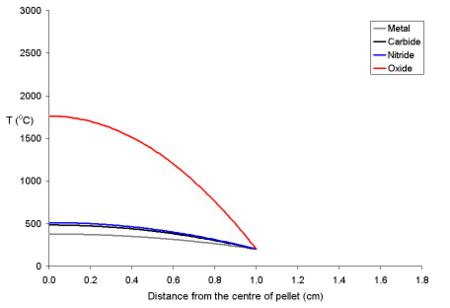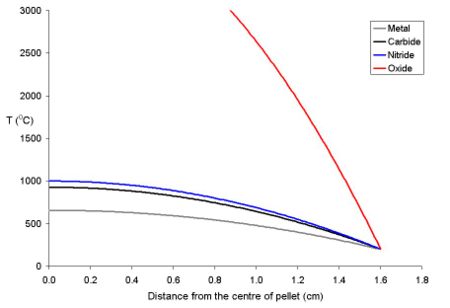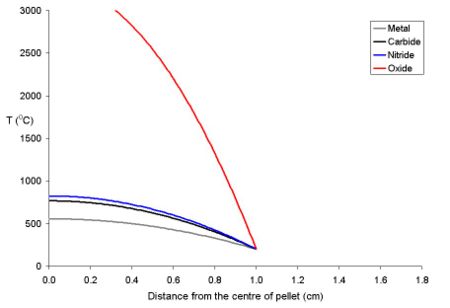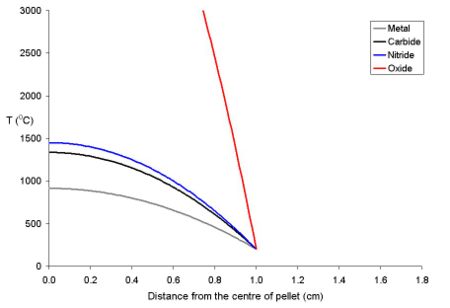Post irradiation examination: Difference between revisions
imported>Howard Arvi Hughes m (Category:CZ Live) |
imported>Mark Rust No edit summary |
||
| Line 1: | Line 1: | ||
'''Post [[Irradiation]] Examination''' (PIE) and fuel behavior is a page devoted to the behaviour of nuclear fuel in a power reactor and the way in which used fuel is studied. It is common that experimental and production fuel will be examined after use in a reactor. [http://www.scn.ro/lepi.htm][http://www.ornl.gov/~webworks/cppr/y2001/pres/114819.pdf] [http://www.rertr.anl.gov/Web2002/2003%20Web/Rugirello.html] [http://www.nea.fr/html/trw/docs/mol98/session3/SIIIpaper2.pdf] Due to the intensely radioactive nature of the used fuel this is done in a [[hot cell]]. A combination of nondestructive and destructive methods are used. | '''Post [[Irradiation]] Examination''' (PIE) and fuel behavior is a page devoted to the behaviour of nuclear fuel in a power reactor and the way in which used fuel is studied. It is common that experimental and production fuel will be examined after use in a reactor. [http://www.scn.ro/lepi.htm][http://www.ornl.gov/~webworks/cppr/y2001/pres/114819.pdf] [http://www.rertr.anl.gov/Web2002/2003%20Web/Rugirello.html] [http://www.nea.fr/html/trw/docs/mol98/session3/SIIIpaper2.pdf] Due to the intensely radioactive nature of the used fuel this is done in a [[hot cell]]. A combination of nondestructive and destructive methods are used. | ||
The PIE is used to check that the fuel is both safe and effective. After major accidents the core (or what is left of it) is normally | The PIE is used to check that the fuel is both safe and effective. After major accidents the core (or what is left of it) is normally sampled and then the samples are subjected to PIE in order to find out what happened. One site where PIE is done is the [[ITU]] which is the [[EU]] centre for the study of highly [[radioactive]] materials. | ||
== Swelling == | == Swelling == | ||
Revision as of 05:18, 23 December 2006
Post Irradiation Examination (PIE) and fuel behavior is a page devoted to the behaviour of nuclear fuel in a power reactor and the way in which used fuel is studied. It is common that experimental and production fuel will be examined after use in a reactor. [1][2] [3] [4] Due to the intensely radioactive nature of the used fuel this is done in a hot cell. A combination of nondestructive and destructive methods are used.
The PIE is used to check that the fuel is both safe and effective. After major accidents the core (or what is left of it) is normally sampled and then the samples are subjected to PIE in order to find out what happened. One site where PIE is done is the ITU which is the EU centre for the study of highly radioactive materials.
Swelling
It is normal for fuel to swell due to thermal expansion during use. A document on the subject can be downloaded from the NASA web site.[5]
Cracking of the fuel
This is due to the fact that as the fuel expands on heating, the core of the pellet expands more than the rim. Because of the thermal stress thus formed the fuel cracks, the cracks tend to go from the centre to the edge in a star shaped pattern.
The temperature of the fuel varies as a function of the distance from the centre to the rim. At distance x from the centre the temperature (Tx) is described by the equation where ρ is the power density (W m-3) and Kf is the thermal conductivity.
- Tx = TRim + ρ (rpellet2 - x2) (4 Kf)-1
To explain this for a series of fuel pellets being used with a rim temperature of 200 oC (typical for a BWR) with different diameters and power densities of 250 Wm-3 have been modeled using the above equation. Note that these fuel pellets are rather large; it is normal to use oxide pellets which are about 10 mm in dimater.
Reference Radiochemistry and Nuclear Chemistry, G. Choppin, J-O Liljenzin and J. Rydberg, 3rd Ed, 2002, Butterworth-Heinemann, ISBN 0-7506-7463-6
Fission gas release
As the fuel is degraded or heated the more volatile fission products which are trapped within the uranium dioxide may become free. For example see J.Y. Colle, J.P. Hiernaut, D. Papaioannou, C. Ronchi, A. Sasahara, Journal of Nuclear Materials, 2006, 348, 229.
P. Wood and G.H. Bannister published a paper on the release of 85Kr, 106Ru and 137Cs from uranium when air is present. It was found that uranium dioxide was converted to U3O8 between about 300 and 500 oC in air. They report that this process requires some time to start, after the induction time the sample gains mass. The authors report that a layer of U3O7 was present on the uranium dioxide surface during this induction time. They report that 3 to 8% of the krypton-85 was released, and that much less of the ruthenium (0.5%) and cesium (2.6 x 10-3%) occurred during the oxidation of the uranium dioxide.[6]
The chemical nature of used uranium dioxide fuel
Overview
Used low enriched uranium nuclear fuel is an example of a nanomaterial which existed before the term nano became fashionable, in the oxide fuel intense temperature gradients exist which cause fission products to migrate. The zirconium tends to move to the centre of the fuel pellet where the temperature is highest while the lower boiling fission products move to the edge of the pellet. The pellet is likely to contain lots of small bubble like pores which form during use, the fission xenon migrates to these voids. Some of this xenon will then decay to form cesium, hence many of these bubbles contain a lot of Cs-137. Also metallic particles of an alloy of Mo-Tc-Ru-Pd tends to form in the fuel. Other solids form at the boundary between the uranium dioxide grains, but the majority of the fission products remain in the uranium dioxide as solid solutions.
For details of how to make a nonradioactive (uranium active) simulation of spent oxide fuel see: Microstructural features of SIMFUEL - Simulated high-burnup UO2-based nuclear fuel, P.G. Lucuta, R.A. Verrall, Hj. Matzke and B.J. Palmer, Journal of Nuclear Materials, 1991, 178, 48-60. This SIMFUEL has been used in a large number of experiments in which attempts are made to predict the long term behaviour of used nuclear fuels within a waste store. One leading worker in this area is David Shoesmith[7][8] who is an electrochemist working in Canada, he tends to use many of the electrochemical experiments normally used for the study of galvanic corrosion to investigate the galvanic of uranium dioxide.
According to Dave Shoesmith's work the nanoparticles of Mo-Tc-Ru-Pd have a strong effect on the corrosion of uranium dioxide fuel. He suggests that when the hydrogen (H2) concentration is high (due to the anaerobic corrosion of the steel waste can) the oxidation of hydrogen at the nanoparticles will exert a protective effect on the uranium dioxide. This effect can be thought of as an example of protection by a sacrificial anode where instead of a metal anode reacting and dissolving it is the hydrogen gas which is consumed.
Uranium
- 96% of the mass is the remaining uranium: most of the original 238U and a little 235U. Usually 235U would be less than 0.83% of the mass along with 0.4% 236U.
Plutonium
- 1% of the mass is 239Pu and 240Pu resulting from conversion of 238U, which may either be considered a useful by-product, or as dangerous and inconvenient waste. One of the main concerns regarding nuclear proliferation is to prevent this plutonium from being used by states other than those already established as Nuclear Weapons States, to produce nuclear weapons. If the reactor has been used normally, the plutonium is reactor-grade, not weapon-grade: it contains much 240Pu and less than 80% 239Pu, which makes it less suitable, but not impossible, to use in a weapon [9]. If the irradiation period has been short then the plutonium is weapon-grade (more than 80%, up to 93%).
Minor actinides
- Traces of the minor actinides are present in used reactor fuel. These are actinides other than uranium and plutonium. These include americium and curium. The amount formed depends greatly upon the nature of the fuel used and the conditions under which it was used. For instance the use of MOX fuel (239Pu in a 238U matrix) is likely to lead to the production of more 241Am than the use of a uranium/thorium based fuel (233U in a 232Th matrix). Also present as a minor actinide is 237Np, this neptunium isotope is fissile but also can be converted into 238Pu by neutron bombardment.
Fission products
- 3% of the mass consists of fission products of 235U (also indirect products in the decay chain), nuclear poisons considered radioactive waste or separated further for various industrial and medical uses. The fission products include every element from zinc through to the lanthanides, much of the fission yield is concentrated in two peaks, one in the second transition row (Zr, Mo, Tc, Ru, Rh, Pd, Ag) while the other is later in the periodic table (I, Xe, Cs, Ba, La, Ce, Nd). Many of the fission products are either non radioactive or only shortly lived radioisotopes. But a considerable number are medium to long lived radioisotopes such as 90Sr, 137Cs, 99Tc and 129I. Research has been conducted by several different countries into partitioning the rare isotopes in fission waste including the Fission Platinoids (Ru, Rh, Pd) and Silver (Ag) as a way of offsetting the cost of reprocessing, however this is not currently being done commercially.
A report has been written which contains estimates of the amounts of different isotopes emitted during the chernobyl fire, the fire and explosion at chernobyl is one of the largest releases of radioactivity into the environment which has occured and hence deserves special attention(OECD NEA report on Chernobyl {ten years on}[10])
| Element | Gas | Metal | Oxide | Solid solution | Radioisotopes | Release at Chernobyl[12] | T required for 10% release from UO2 | T required for 10% release from U3O8 |
|---|---|---|---|---|---|---|---|---|
| Br | Yes | - | - | - | - | - | - | - |
| Kr | Yes | - | - | - | 85Kr | 100% | - | - |
| Rb | Yes | - | Yes | - | - | - | - | - |
| Sr | - | - | Yes | Yes | 89Sr and 90Sr | 4-6% | 1950 K | - |
| Y | - | - | - | Yes | - | 3.5% | - | - |
| Zr | - | - | Yes | Yes | 95Zr | 3.5% | 2600 K | - |
| Nb | - | - | Yes | - | - | - | - | - |
| Mo | - | Yes | Yes | - | 99Mo | >3.5% | - | 1200 K |
| Tc | - | Yes | - | - | - | - | - | 1300 K |
| Ru | - | Yes | - | - | 103Ru and 106Ru | >3.5% | - | - |
| Rh | - | Yes | - | - | - | - | - | - |
| Pd | - | Yes | - | - | - | - | - | - |
| Ag | - | Yes | - | - | - | - | - | - |
| Cd | - | Yes | - | - | - | - | - | - |
| In | - | Yes | - | - | - | - | - | - |
| Sn | - | Yes | - | - | - | - | - | - |
| Sb | - | Yes | - | - | - | - | - | - |
| Te | Yes | Yes | Yes | Yes | 132Te | 25-60% | 1400 K | 1200 K |
| I | Yes | - | - | - | 131I | 50-60% | 1300 K | 1100 K |
| Xe | Yes | - | - | - | 133Xe | 100% | 1450 K | - |
| Cs | Yes | - | Yes | - | 134Cs and 137Cs | 20-40% | 1300 K | 1200 to 1300 K |
| Ba | - | - | Yes | Yes | 140Ba | 4-6% | 1850 K | 1300 K |
| La | - | - | - | Yes | - | 3.5% | 2300 K | - |
| Ce | - | - | - | Yes | 141Ce and 144Ce | 3.5% | 2300 K | - |
| Pr | - | - | - | Yes | - | 3.5% | 2300 K | - |
| Nd | - | - | - | Yes | - | 3.5% | 2300 K | - |
| Pm | - | - | - | Yes | - | 3.5% | 2300 K | - |
| Sm | - | - | - | Yes | - | 3.5% | 2300 K | - |
| Eu | - | - | - | Yes | - | 3.5% | 2300 K | - |
J.Y. Colle, J.-P. Hiernaut, D. Papaioannou, C. Ronchi and A. Sasahara, Journal of Nuclear Materials, 2006, 348, 229-242 reported the releases of fission products and uranium from uranium dioxide (from spent BWR fuel, burn-up was 65 GWd t-1) which was heated in a Knudsen cell. Fuel was heated in the Knudsen cell both with and without preoxidation in oxygen at c 650 K. It was found even for the noble gases that a high temperature was required to liberate them from the uranium oxide solid. For unoxidized fuel 2300 K was required to release 10% of the uranium while oxidized fuel only requires 1700 K to release 10% of the uranium.
According to the report on Chernobyl used in the above table 3.5% of the following isotopes in the core were released 239Np, 238Pu, 239Pu , 240Pu, 241Pu and 242Cm.




